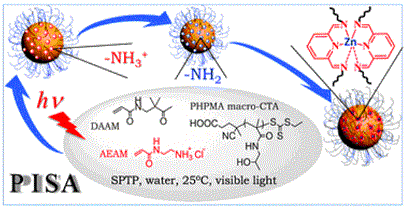Yanyan Jiang, Na Xu, Jie Han, Qiuping Yu, Lei Guo, Pan Gao, Xinhua Lu and Yuanli Cai*(蔡远利)
The Suzhou Key Laboratory of Macromolecular Design and Precision Synthesis,Department of Polymer Science and Engineering, College of Chemistry, Chemical Engineering and Materials Science, Soochow University
Polym. Chem., 2015,6, 4955-4965
Self-assembly of amphiphilic block copolymers in water suffers from the undesired encapsulation of hydrophobic reactive motifs in a core-forming block, which deteriorates their performance as aqueous catalysts. This problem can be circumvented by polymerisation-induced self-assembly (PISA). Herein, we report a new strategy for one-pot synthesis of reactive block copolymer nanoparticles whose hydrophobic reactive motifs decorate the surrounding core–shell interfaces. We demonstrate fast RAFT aqueous dispersion polymerisation of a commercially available specialty monomer, diacetone acrylamide (DAAM), under visible light irradiation at 25 °C. PISA is induced by polymerisation via sequential dehydration, phase separation and reaction acceleration, thus achieving complete conversion in 30 min. The replacement of minimal DAAM by an NH3+-monomer induces slight hydration of the core-forming block, and thus a low polydispersity of the resulting statistic-block copolymer. Moreover, simultaneous in situ self-assembly and chain growth favour the adjustment of newly-added NH3+-units outward to core–shell interfaces while the major DAAM units collapse into hydrophobic PISA-cores. Both lead to timely and selective self-assembly into the new reactive nanoparticles whose NH3+-motifs decorate the surrounding core–shell interfaces. These nanoparticles are well-suited for fabrication of advanced nanoreactors whose hydrophobic dative metal centres decorate the surrounding interfaces via simultaneous imine conversion and Zn(II)-coordination. Such PISA-nanostructures endow hydrophobic metal centres with a huge and accessible specific surface area and are stabilized by water-soluble shells. Therefore, this strategy holds fascinating potential for the fabrication of metalloenzyme-inspired aqueous catalysts.

链接://pubs.rsc.org/en/Content/ArticleLanding/PY/2015/C5PY00656B#!divAbstract